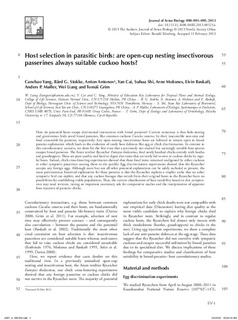| dc.contributor.author | Yang, Canchao | |
| dc.contributor.author | Stokke, Bård Gunnar | |
| dc.contributor.author | Antonov, Anton Tinchov | |
| dc.contributor.author | Cai, Yan | |
| dc.contributor.author | Shi, Suhua | |
| dc.contributor.author | Moksnes, Arne | |
| dc.contributor.author | Røskaft, Eivin | |
| dc.contributor.author | Møller, Anders pape | |
| dc.contributor.author | Liang, Wei | |
| dc.contributor.author | Grim, Tomas | |
| dc.date.accessioned | 2017-10-09T10:44:04Z | |
| dc.date.available | 2017-10-09T10:44:04Z | |
| dc.date.created | 2013-02-12T07:03:39Z | |
| dc.date.issued | 2013 | |
| dc.identifier.citation | Journal of Avian Biology. 2013, 44 (3), 216-220. | nb_NO |
| dc.identifier.issn | 0908-8857 | |
| dc.identifier.uri | http://hdl.handle.net/11250/2459152 | |
| dc.description.abstract | How do potential hosts escape detrimental interactions with brood parasites? Current consensus is that hole-nesting and granivorous birds avoid brood parasites, like common cuckoos Cuculus canorus , by their inaccessible nest-sites and food unsuitable for parasites, respectively. Any open-nesting insectivorous hosts are believed to remain open to brood parasite exploitation which leads to the evolution of costly host defences like egg or chick discrimination. In contrast to this coevolutionary scenario, we show for the fi rst time that a previously not studied but seemingly suitable host species escapes brood parasites. Th e Asian verditer fl ycatcher Eumyias thalassinus , feed newly hatched chicks entirely with beetles and grasshoppers. Th ese are poor quality and hard to digest diet items that are rarely fed to own or cuckoo chicks by regular hosts. Indeed, chick cross-fostering experiments showed that these food items remained undigested by either cuckoos or other sympatric passerines causing them to die quickly. Egg discrimination experiments showed that the fl ycatcher accepts any foreign eggs. Although most but not all other potential explanations can be safely excluded at present, the most parsimonious historical explanation for these patterns is that the fl ycatcher exploits a trophic niche that no other sympatric bird can exploit, and that any cuckoo lineages that switch from their original hosts to the fl ycatcher have no possibilities for establishing viable populations. Th us, the current classifi cation of host suitability based on diet composition may need revision, raising an important cautionary tale for comparative studies and the interpretation of apparent host rejection of parasitic chicks. | nb_NO |
| dc.language.iso | eng | nb_NO |
| dc.publisher | Wiley | nb_NO |
| dc.title | Host selection in parasitic birds: are open-cup nesting insectivorous passerines always suitable cuckoo hosts? | nb_NO |
| dc.type | Journal article | nb_NO |
| dc.type | Peer reviewed | nb_NO |
| dc.description.version | acceptedVersion | nb_NO |
| dc.source.pagenumber | 216-220 | nb_NO |
| dc.source.volume | 44 | nb_NO |
| dc.source.journal | Journal of Avian Biology | nb_NO |
| dc.source.issue | 3 | nb_NO |
| dc.identifier.doi | 10.1111/j.1600-048X.2013.00123.x | |
| dc.identifier.cristin | 1009103 | |
| dc.relation.project | Norges forskningsråd: 218144 | nb_NO |
| dc.description.localcode | This is the peer reviewed version of the following article: Host selection in parasitic birds: are open-cup nesting insectivorous passerines always suitable cuckoo hosts?, which has been published in final form at http://onlinelibrary.wiley.com/doi/10.1111/j.1600-048X.2013.00123.x/abstract. This article may be used for non-commercial purposes in accordance with Wiley Terms and Conditions for Self-Archiving. | nb_NO |
| cristin.unitcode | 194,66,10,0 | |
| cristin.unitname | Institutt for biologi | |
| cristin.ispublished | true | |
| cristin.fulltext | original | |
| cristin.fulltext | postprint | |
| cristin.qualitycode | 1 | |
